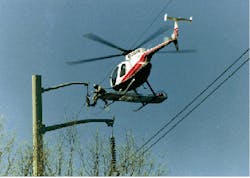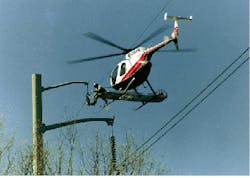High-wire act brings fiber optics to the Philadelphia area
High-wire act brings fiber optics to the Philadelphia area
Michael Wood and Richard Helmuth, Peco Energy Co.
With costs increasing for leased lines, Peco Energy`s Telecommunications Division in Philadelphia developed a plan to construct a multi-node fiber-optic network that features synchronous optical network technology and Sonet radio capabilities. Operating two natural gas production facilities, 19 gas gate stations and nine electric-generating stations, and owning a portion of three major power plants, the company filled its communications bandwidth plate and demanded quicker information delivery.
Peco Energy is a utility that provides electric and natural gas service and employs 7400 people. It serves 1.5 million electric customers in southeastern Pennsylvania and northeastern Maryland, and supplies gas to 374,000 customers in Philadelphia`s four suburban counties. The total area served by Peco Energy and its subsidiaries covers 2475 square miles with a population of 3.7 million.
As in most other utilities, Peco Energy`s computer operations were centrally located. Corporate reorganizations with decentralized functions at sites throughout the service territory pushed the number of local area networks upward by geometric proportions. The need to interconnect this growing population of microcomputers forced a conversion from the centralized information systems to distributed processing. This initial formation of nodal networking began during the 1980s.
Reliable telecommunications
The primary philosophy driving the early design and development of the company`s telecommunications topology was the need for reliable telecommunications transport and data exchange. Peco Energy`s first network consisted of various leased analog, digital, and proprietary microwave voice and data transport arrangements. This network connected several centrally located mainframe computers at the company`s headquarters in Center City Philadelphia with six city/suburban division offices, the power plant sites and a major utility support center in a star configuration. At that time, this system supported separate voice and data networks.
Peco Energy`s new information technologies responded to management`s increasing need to use and share timely, accurate and reliable information. In modern business, the interorganization information exchange relies on the ability to integrate wireless and directly connected wide area networked facilities.
In early 1990, Peco Energy entered the age of full wideband digital networking when its first 6-node Network Equipment Technologies T-1 multiplex system went fully operational. The company also began moving toward a ring topology, building multiple communications paths in a self-healing network for greater reliability. The installation of high-capacity voice and data-link redundancy marked a new phase of network sophistication. Peco Energy enhanced its network management capabilities and increased overall network reliability.
In three years, the network more than quadrupled in size and now serves 1500 terminals and 6500 workstations. Peco Energy currently has 25 Network Equipment Technologies digital nodes comprising more than 100 leased T-1 lines. This system supports 45 Plax nodes networked together with integrated services digital network technology, integrated voice mail and automatic call distribution. Peco Energy installed more than 40 nodes of Cisco routers, which support many different business applications, such as computer-aided design, plant-management systems, financial systems and Internet access. It also installed a 640-port interactive voice response system for customer service, storm restoration and business applications. This new system was fully integrated into the network with T-1 and computer telephone integration to the corporate main frame.
The transition into advanced information transport technology was coupled with the complete conversion of all major Peco Energy locations--45 in all, during a 16-month period--to the Northern Telecom Meridian 1 PBX platform architecture.
The network has several benefits. Besides a cost savings of $2.38 million, it provides automatic relay protection capabilities for transmission lines and local electric substations throughout the serving area, thereby improving service reliability for customers, and provides a vehicle for high-speed, high-capacity integrated voice and data communications at OC-48 Sonet levels. In addition, the network has a tremendous capacity for future growth.
The fiber-optic infrastructure comprises miles of underground conduit, wood pole installations and transmission tower rights-of-way. The project, which has been dubbed the Enterprise Communications Network, involves the replacement of existing aerial static wire with Fujikura optical ground wire that contains 24/36 or 36/72 fiber-optic strands. The static wire is situated above the 230,000-volt conductors and protects the lower lines from lightning strikes. The joint efforts of the telecommunications division and the transmission and distribution departments have satisfied the core business requirements.
The use of optical ground wire on top of the transmission towers provides a reliable source of transmission path survivability. In nearly 40 years, Peco Energy has never lost a transmission ground wire, even though the region last year suffered historic winter ice and wind storms. Because the company uses its own right-of-way, make-ready engineering and construction are virtually unnecessary.
Fiber deployment by helicopter
In four recent builds, Peco Energy attached the optical ground wire using specially trained helicopter crews that move from tower to tower, attaching the new cable to the transmission towers. This attention-grabbing high-wire act is gaining popularity within the industry as an installation method that cuts costs and project time. The construction procedures and techniques continually improve and take into account safety, cost and installation survivability requirements. Agrotors Inc. in Gettysburg, PA, serves as the helicopter contractor with trained line crews.
To prepare for the installation, the aircraft lineman dons customary in-flight dress covered with special overalls, which include a leg-affixed tool pouch and a safety harness. A flight helmet permits two-way communications between the pilot and lineman. The lineman, who is perched on a 4䂀-foot platform suspended beneath a helicopter, performs the aerial work. Peco Energy construction crews on the ground work in tandem with Agrotors` ground crews at a pre-designated landing zone and staging area near the tower line planned for that day. The first stage involves placement of pulling wheels and then stringing the fiber tower-to-tower over a five-mile path. The aircraft flies the lineman from tower to tower, allowing the final cable attachments in minutes.
When the helicopter cannot be used because of safety or access concerns, Peco Energy`s own construction team, which is trained in fiber-optic splicing and testing, uses aerial cranes to handle the fiber installation.
By the end of 1995, communications coverage will be provided with a 70-mile digital microwave network and more than 200 miles of fiber-optic lines. Several other projects are in the planning stages.
The fiber-optic infrastructure has become a vital ingredient for the company to achieve its business process reengineering goals. This backbone, coupled with the new emerging wireless technologies, enables Peco Energy to field an untethered, multi-functional work force. This ability to adapt leading edge information technologies will successfully lead Peco Energy into the 21st century. q
Michael Wood is senior media relations representative, and Richard Helmuth is manager for telecommunications at Peco Energy Co., Philadelphia.An aerial lineman makes the final attachment of the optical ground wire (static wire) to the transmission tower.

